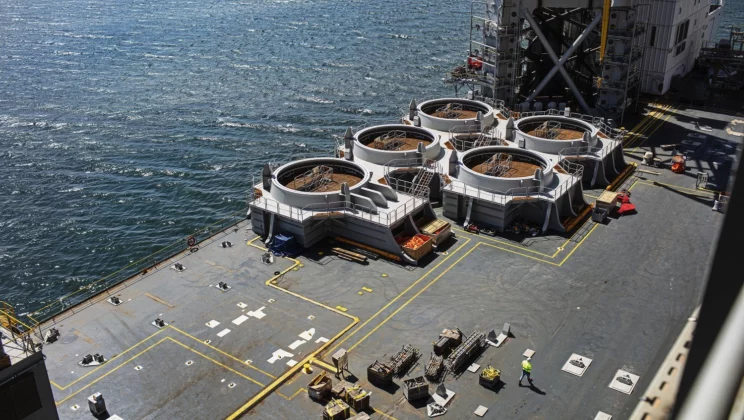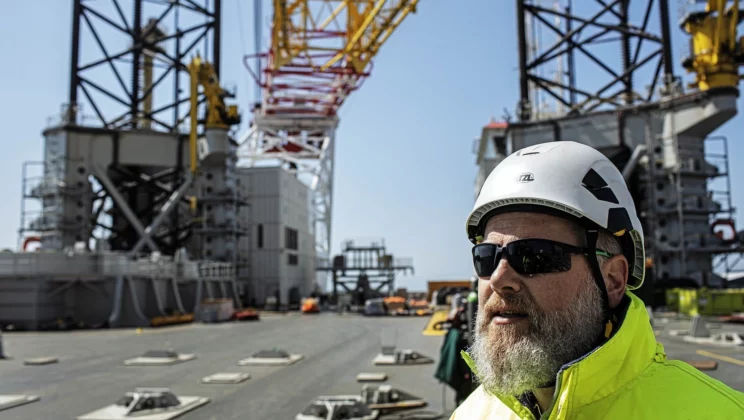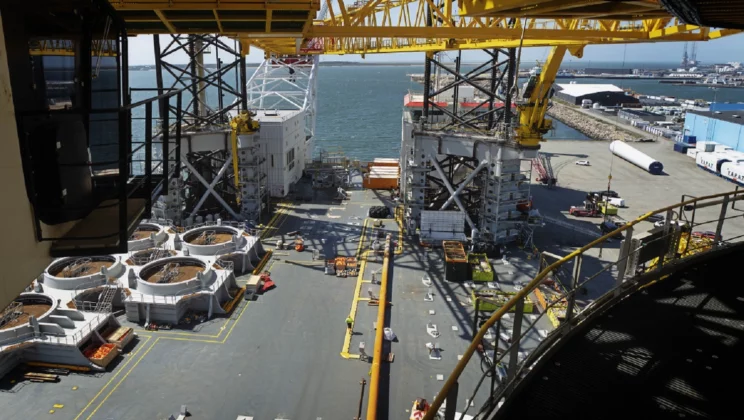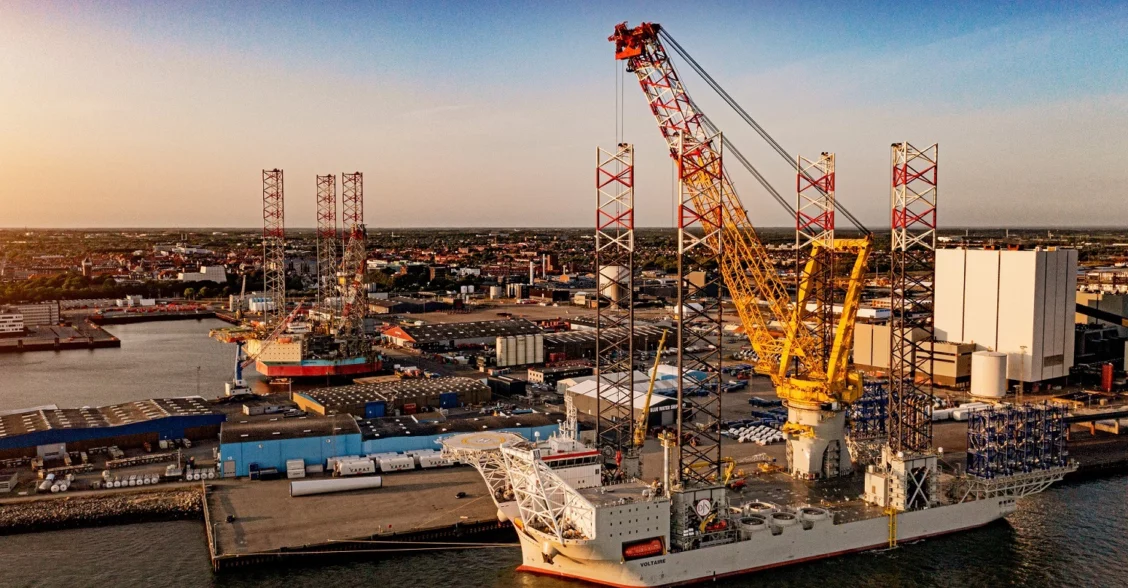The vessel is fitted with a crane that has the capacity to lift the equivalent of 530 African elephants. The Voltaire is the name of the huge installation vessel that docked at Port Esbjerg for a few weeks to be readied for her first assignment. The vessel’s Captain, Frederic Bruyninckx, enjoyed visiting western Jutland and not least the ice cream he managed to find time to have.
The Voltaire is an installation vessel the size of a skyscraper.
Moored at the pier along with other giants, she still seems to be reaching that bit further into the blue sky, confidently looking out over all the other vessels as if to say: I’m the biggest!
And that’s true. The Voltaire is currently the world’s largest installation vessel.
Her lift spans seven storeys, the vessel is 182 metres from end to end and 60 metres wide. She has a maximum draught of 7.5 metres, a speed of 11.5 knots at full throttle and, not least, a huge crane.
The crane tower is the size of the Round Tower in Copenhagen. The crane has a lifting capacity of 3,200 tonnes. That is the equivalent of 530 African elephants or more than 237 city buses. In one go.
More about the crane later.

Voltaire can carry five wind turbines at a time. Both towers, nacelles, and wings are transported on deck.
Shoes of 250 square metres
Ordered in 2019, the COSCO Shipping Shipyard in China delivered the Voltaire to Jan de Nul Group of Luxembourg in December 2022. She had a stopover for a few weeks at Port Esbjerg to be readied for her first, big assignment.
Wearing helmets and safety shoes, we are led through narrow corridors, stairs and self-closing doors up to the bridge of the vessel, where Captain Frederic Bruyninckx is looking out over the large deck, the size of one and a half football pitches.
He talks enthusiastically about his vessel, explaining that the legs are 130 metres tall and that each shoe on the legs is 250 square metres.
As he speaks, dozens of men are moving around on the deck and on the crane.
“Maintenance and preparations,” says Captain Bruyninckx, nodding towards the many ant-like figures on the deck, who are getting ready to receive foundations, towers, nacelles and blades. This vessel is able to transport and install all of the above.
The captain is Belgian, 53 years old, and has worked in wind for Jan de Nul Group since 2016. He is one of the vessel’s 110 crewmembers.
Some 40 per cent of the crew are involved in operating the vessel, while the installation crew account for about 60 per cent.
“We’re very happy to be at Port Esbjerg, and I’ve been here many times before. There are a lot of relevant companies based at the port that provide service and maintenance for our vessels,” says Captain Bruyninckx.
“And they have very good ice cream in this city,” he says with a smile.
The night before, he had been for a medical check-up and stumbled upon an ice cream shop next to the medical centre. That was a temptation he could not resist, so he strolled back through the city to the Voltaire enjoying a proper sized ice cream.
Filling up on calories when you have a big job coming up can be a good thing! And a big job is definitely what is in store for the Voltaire and Captain Bruyninckx. Over the next couple of years the ship will be installing enormous turbines in the North Sea.

Kaptajn Frederic Bruyninckx has been setting up wind for 10 years and is still fascinated by the enormous dimensions.
Christmas in China and biking around Esbjerg
The vessel and her crew celebrated Christmas in China and took delivery of the Voltaire before sailing to the Emirates where the components designed to keep the turbine towers in place during transport were installed. They then set course for Esbjerg in mid-March. This was a voyage that took no less than seven weeks because the vessel is too large to sail through the Suez Canal.
The crew is on duty in shifts. During transport, the crew operating the vessel is on or off duty for six-week periods. When the vessel installs turbines, they are on or off duty for two weeks at a time.
Alcohol is banned on the vessel, including while docked at a port. However, crew members are allowed to go ashore and experience the city they are in, so Captain Bruyninckx knows Esbjerg quite well. In fact, he usually cycles around the city.
“A very pleasant and clean city,” he says with a smile.
The vessel has a maximum draught of 7.5 metres, which means many ports are not deep enough for the Voltaire.
The mayor and the parrot
“You might call me a mayor,” says Captain Bruyninckx. The way he describes his own job function is far from that of a classic captain standing on the bridge and guiding his vessel safely into port.
“The captain is more like a manager. Or the village mayor. He is in touch with many clients and holds many meetings with people internally,” he explains.
The captain’s job is to take care of everything from making sure the vessel gets the right spare parts to handling staff and sending “lots of e-mails”. In his own words, at least half of his time is spent doing office work.
From his position on the bridge, Captain Bruyninckx now looks out onto the deck again, where the men are preparing for the next project. The blades are more than 100 meters long.
“The next generation turbines will have 125-metre blades, and that means we’re looking at 20 MW turbines,” says Captain Bruyninckx.
The Voltaire is built to last at least twenty years, so her dimensions are designed to handle the expected increases in turbine size.
The “mayor” leads us to his normal office space located in a couple of compartments inside the vessel. There is a meeting room and a standard workstation, similar to what you would find at most office workplaces.
“So you see, my reality is a far cry from that of the pirate captain with a wooden leg,” he laughs.
But then again. At his home in France, he actually has a parrot, which he says chose him because it stole his wallet from his chest pocket. He believes that was a sign that he was meant to buy the parrot. So Captain Bruyninckx has a parrot that likes to sit on his shoulder when he is at home!
Bench press, a home cinema and a future-proof crane
We follow the captain down a few stairs to the fitness room, which is the size of most regular gyms. It has everything from a bench press to treadmills, free weights and a sauna if you need to get warm. The weights are very popular with the installation crew.
We walk past the home cinema which seats about thirty people. A few crew members are currently playing on the PlayStation. We pass the canteen, which the night before served spareribs for the 110 crew members, all of whom have their own cabins incidentally.
The canteen staff were recently treated to a visit from a Michelin-starred chef who came onboard to provide inspiration to cook even better meals.
The 110 crew members come from nine different European countries. Only six of them are women.
The vessel lies steady in the water, especially with the legs unfolded. Steady enough to also have a pool table onboard, so the crew can enjoy a game on the green cloth. As in most pubs and bars, the table is placed close to the bar, which is filled with non-alcoholic beers and non-alcoholic cocktail ingredients. That is less common.
The captain opens a door and suddenly we are outside on deck.
We walk up to the crane, which is installed on a tower that seems to be over thirty metres tall. This is an exceptional crane. Turbine towers can weigh up to 800 tonnes, nacelles up to 600 tonnes and blades up to 60 tonnes. Those are all easy lifts for the crane.
It can lift 3,200 tonnes. If you lined up 530 African elephants, it would be able to lift them all.
“It’s future-proofed,” says Captain Bruyninckx.
The foundations in particular are exceptionally heavy, so it takes a titan to lift them onboard and place them correctly at sea. They weigh up to 2,000 tonnes.
The captain greets a couple of people walking by. They represent the client. The vessel often has clients onboard, and the insurance companies also spend a lot of time here. These are expensive goods being handled here.
From the cab of the crane, the people on the deck once again look like ants. The chair from where the giant is operated looks like a gamer chair and has a joystick for each hand. The chair is adjustable, allowing it to be raised or lowered to give the operator the best possible view.
We swivel the chair a bit to one side and coming into view is the Voltaire’s slightly smaller sister vessel, the Vole au vent, which is also being prepared for future assignments involving installation of offshore wind turbines.
The crane operator admits that operating the crane can be a little nerve-wracking, but it’s entirely reliable.
We walk back to the bridge to get ready to say goodbye.

The view from the crane at Voltaire. The deck is equivalent in size to one and a half soccer field.
Like a family
“We are like family,” says the captain about his crew.
They rely on each other and treat each other with respect. Many of them have been at sea together for years.
“I like to say that people are happy as long as we have water, bread and internet onboard,” the captain says with a smile.
The vessel is due to depart Esbjerg a few days later, but it won’t be with the captain at the helm. The vessel is controlled by a computer and not by way of a helm or a joystick. It is impossible to see the entire vessel from the bridge, so instead there are about fifty cameras installed to monitor the vessel.
As we are about to leave, Captain Bruyninckx exclaims:
“I’m still in awe by the sheer size and fascinated that she’s able to lift such gigantic components out to sea and install them. That’s why I’m still doing this after so many years.”

Voltaire as seen from the air during the visit to Esbjerg. The ship is the world’s largest of its kind with its 180 meters.
Go to overview

